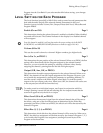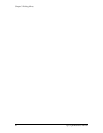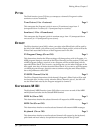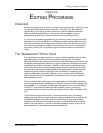
Chapter 5: Editing Mixes
46 QS7/QS8 Reference Manual
POLYPHONY IN MIX PLAY MODE
The QS has 64-note polyphony. In Mix Play Mode, if you have all 16 MIDI channels
assigned to the same keyboard range, and each channel’s Program has only one
active Program Sound, you’ll have 4-note polyphony as you play the keyboard (but a
really thick layer...). This is extreme, of course, but should tell you what you can
expect when you really pile on the layers from the keyboard.
USING THE QS AS A MASTER KEYBOARD
Mix Play Mode gives the QS the capabilities of a MIDI master keyboard. You can
layer the QS’s internal sounds with an external synthesizer's sounds without using
up internal polyphony by adjusting the proper parameters in the Mix Edit mode.
Example: You can have 2 layers (or a split) played directly from the QS,
simultaneously playing on external synthesizers using a MIDI channel which has its
internal QS’s Program Enable parameter turned OFF.
SETTING THE MIDI OUT CHANNELS FOR A MIX IN
GLOBAL MODE
The QS offers a wide variety of ways to set the MIDI output. It is very easy in
Program Play Mode; you just use the [
▲
PAGE] and [PAGE
▲
] buttons to set the
MIDI OUT channel for the whole instrument. But when using the QS in Mix Play
Mode, you may want to transmit on several MIDI channels at once, and to
temporarily isolate certain channels within a Mix. This is done with the Keyboard
Mode function.
➀ Press [EDIT SELECT] and then [BANK
▲
].
Note the word "Global" in blue under the BANK key.
➁ Press [PAGE
▲
] five times to get to Page 6.
The display should look like this:
ED:GLOBAL „œ
KBD MODE: N ORMAL
➂ Use the [▲ VALUE] and [VALUE ▼] buttons or the CONTROLLER [D] slider to
set the Keyboard Mode.
The options are: NORMAL, CH SOLO and OUT 1 — OUT 16.
NORMAL. In this mode, the MIDI channels sent out will correspond to whatever
layers or splits the Mix is set up for. For example, in a Mix bank, there may be
several Mixes in which the keyboard is split in two or more ways from left to right;
each of these “zones” is linked to a different set of channels. As you play through
each zone, it can be set to send MIDI messages corresponding to that key range and
trigger the corresponding channels. Note that certain controllers such as pitch bend
and aftertouch will send on all channels at once. The MIDI Monitor indicators in the
display will show which channels are enabled; but if the QS is sending a MIDI OUT
message on a channel without its internal sound being enabled, it will not show on
the MIDI Monitor.


















